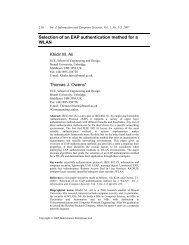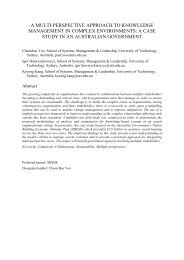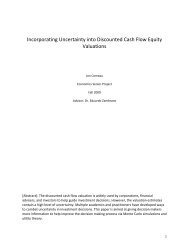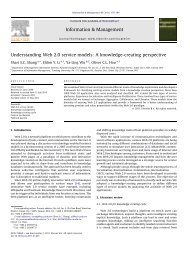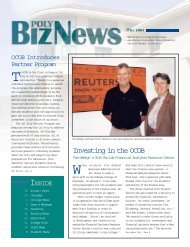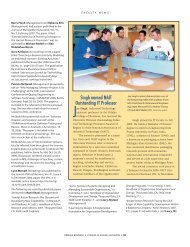FACULTY REPORTSCan Behavioral Finance Explain Stock Prices?BY SAMIR DUTT, ASSOCIATE PROFESSOR, FINANCE AREAIntroductionIf an investor buys a risk-free asset like a U.S. Treasurybond, he or she can be certain that the bond will pay thepromised amount if it is held to maturity. The return onthis investment is determined by how much the investorpays for the bond, and is commonly referred to as the riskfreerate. What if the investor buys an asset like IBM stock?Buying IBM stock, or any corporate stock for that matter,does not have a predictable outcome. The investment maymake a pr<strong>of</strong>it or a loss. Its pay<strong>of</strong>f is uncertain. What shouldit cost? Since the pay<strong>of</strong>f is uncertain, it must, on average,provide a higher return than the risk-free rate because noone would buy an asset that was both risky and paid out alower return on average than a Treasury bill. But how muchmore should the risky asset pay out relative to the risk-freeasset? How do we determine an asset’s risk premium?The capital asset pricing model, or CAPM (asset riskpremium = ß x market risk premium), provides one answer.It specifies the premium that must be paid by a riskyasset like stock over the return from holding a risk-free assetlike a U.S. Treasury bill in terms <strong>of</strong> the risky asset’s beta (ameasure <strong>of</strong> how closely the risky asset’s returns track theups and downs <strong>of</strong> the return on the market portfolio) andthe market portfolio’s risk premium, with the market portfolioproxied by a broad-based index like the S&P 500 or theWilshire 5000.Tests <strong>of</strong> the CAPM against market data, however, donot work particularly well. Recent work by Fama andFrench (1992) suggests that a stock’s beta may be essentiallyuncorrelated with its risk premium, which implies thatthe CAPM cannot reliably be used to calculate the fair price<strong>of</strong> an asset.How about CAPM-like multifactor models, like theArbitrage Pricing Theory, which have become fund managementindustry standards? They work in the sense that regressingrisk premiums against a sufficient multitude <strong>of</strong>factors can explain more and more <strong>of</strong> an asset’s excess returnover the risk-free rate. This is an ad hoc procedure, notdeeply rooted within the Expected Utility Theory paradigmfavored by economists, who prefer to obtain equilibriumasset prices from investors’ beliefs, preferences, and endowments(as the CAPM does).Expected Utility Theory (EUT) is, very simply, a wayto rank gambles from best to worst. Consider two gambles,A and B. A: win $10 (50 percent) or lose $10 (50 percent).B: win $11 (50 percent) or lose $10 (50 percent). If theyboth cost the same, any rational person would prefergamble B to gamble A. This is, however, a very simple situationwith a very obvious answer. In more complex situations,as when an investor chooses among all the stockslisted on the New York Stock Exchange and puts togetheran investment portfolio, it is not as easy to decide whichstocks to choose and how much to invest in each stock.Expected Utility Theory provides the investor with one set<strong>of</strong> tools to rank all possible portfolios from best to worst,and to then choose a portfolio that is compatible with hisor her appetite for risk (a retiree’s optimal portfolio mightbe mainly in U.S. Treasuries, while a young woman’s optimalportfolio might be mainly in equities, with only a littlein Treasuries).Can we find a better set <strong>of</strong> tools for ranking portfolios,a set more in line with how investors actually express theirpreferences in the market? Can we find a way to calculatethe risk premium <strong>of</strong> an asset based on the latest understanding<strong>of</strong> how investors respond to risk and reward? Yes, butfirst some spadework.The assumptions underlying the CAPM are part <strong>of</strong> thestandard canon <strong>of</strong> finance and economics, and are not to betoyed with lightly. The underlying assumptions are (i) thatinvestors prefer more to less; (ii) that investors be riskaverse expected utility optimizers; and (iii) that asset returnsbe normally distributed. The first assumption, that investorsprefer more to less, cannot seriously be doubted,while the last assumption, that <strong>of</strong> asset normality, is a technicalrequirement for the CAPM to hold for a general class<strong>of</strong> concave utility functions (investors’ appetite for risk). Itis to the second assumption, that investors maximize theexpected utility <strong>of</strong> their total wealth, that we must look forchange.That individuals presented with gambles make choiceswhich violate the foundational axioms <strong>of</strong> EUT has beenknown since the work <strong>of</strong> Allais (1953) more than 50 yearsago. Since then, experiments in the laboratory and in thefield have revealed further systematic violations <strong>of</strong> theseaxioms (Camerer 1992). Many <strong>of</strong> the anomalies uncoveredhave a somewhat esoteric flavor, involving as they do violations<strong>of</strong> the “independence” axiom, the “transitivity”axiom, and others. A more easily palpable anomaly regardingrisk aversion is provided by an example in Rabin andThaler (2001), who assert that despite the “central place”<strong>of</strong> “expected utility maximization <strong>of</strong> a concave utility-<strong>of</strong>wealthfunction ... this explanation for risk aversion is notplausible in most cases where economists invoke it.”Rabin and Thaler (2001): Given that “Johnny is a riskaverseexpected utility maximizer, and that he will alwaysturn down the 50-50 gamble <strong>of</strong> losing $10 or gaining $11,”the authors ask “What else can we say about Johnny?Specifically, can we say anything about bets Johnny willbe willing to accept in which there is a 50 percent chance14 ❚ ANNUAL REPORT 20<strong>07</strong>-<strong>08</strong>
FACULTY REPORTS<strong>of</strong> losing $100 and a50 percent chance<strong>of</strong> winning someamount $Y?” It turnsout that Johnny willshaped value functionhas a kink atthe origin; (iv)while utility iseverywhere concave,turn down anyvalue is con-such bet, no matterhow large Y is. Forexample, Johnnywill turn down a50-50 lose $10/win$2.5 trillion bet! Theonly assumptionsFigure 1: (a) A standard utility function defined over total wealthcave over gains andconvex over losses,i.e., investors arerisk averse whenthey’re winning andrisk-seeking whenthey’re losing – this(asset integration). The concavity <strong>of</strong> the curve ensures risk aversion.required to reachcaptures two facts:(b) A Kahneman-Tversky style value function defined over losses and gains ratherthis startling conclusionare that Johnnyprefer a sure gain <strong>of</strong>laboratory subjectsthan over total wealth. Note (i) the kink at the origin <strong>of</strong> the value function, and(ii) the red lines indicating the pleasure (pain) caused by unit gain (loss).be an expected utilityThe relatively greater pain caused by unit loss is called “loss aversion.”$100 to the possibilityoptimizer withan increasing andconcave utility-<strong>of</strong>-wealth function. Rabin and Thaler (ibid.)go on to suggest that “Johnny would, <strong>of</strong> course, have to beinsane to turn down bets like” these. 1 Suffice it to say thatdecision theorists now regard EUT to be normative in character(how individuals should behave) rather than descriptive(how individuals actually behave).A very considerable effort has gone into formulatingalternatives that capture the systematic patterns whichemerge from field and laboratory experiments in which subjectsare presented with a variety <strong>of</strong> gambles (lotteries, alsoknown as “prospects”) and asked to choose among them.The weight <strong>of</strong> evidence suggests that the best candidates fora descriptive theory <strong>of</strong> choice must have two features: (i)an S-shaped relative value function instead <strong>of</strong> the monotonicallyincreasing and concave utility-<strong>of</strong>-wealth function usedin EUT, and (ii) a (subjective) nonlinear transformation <strong>of</strong>the probabilities associated with future outcomes, with verylow probabilities over-weighted (people buy lottery tickets),very high probabilities under-weighted (smokers discountthe risk <strong>of</strong> falling terribly ill), and mid-range probabilitiesleft unchanged. These “decision weights,” which need notsum to one, are used in place <strong>of</strong> probabilities when calculatingthe expected “value” <strong>of</strong> a risky prospect. Figure 1displays a typical EUT-style utility function in panel (a), anda typical behavioral value function in panel (b). Note that(i) utility is defined over total wealth, i.e., the outcomesfrom a gamble are added to pre-gamble wealth before calculatingexpected utility (this is called “asset integration”);(ii) value, however, is calculated without reference to theimpact on a subject’s current or reference wealth; (iii) the S-<strong>of</strong> winning$200, and that theyprefer the possibility <strong>of</strong> losing $200 to a sure loss <strong>of</strong> $100;(v) the slope <strong>of</strong> the value function over gains in panel 2(b)is less than that <strong>of</strong> the value function over losses – as thered lines in panel 2(b) indicate, unit loss in wealth causesmore pain than unit gain in wealth causes pleasure, i.e., investorsare loss averse. The combination <strong>of</strong> decision weightsand an S-shaped value function with the properties outlinedin (ii) through (v) goes a long way in accounting for thechoice behavior exhibited by individuals in real life(Camerer 1992), and avoids anomalies like EUT Johnny’s“insane” behavior.A CAPM-like Model for Loss AversionThe easiest way to obtain a CAPM-like relative pricingmodel for Prospect Theory-style loss averse investors is touse the geometric argument invoked by Sharpe (1964) toget the usual CAPM for mean-variance optimizers. The argumentis illustrated schematically in Figure 2 (see nextpage), using the familiar mean and volatility measures <strong>of</strong>reward and risk. The horizontal axis represents the risk <strong>of</strong>a portfolio <strong>of</strong> assets, while the vertical axis represents theassociated reward. The wedge-shaped region represents thefeasible region, i.e., all portfolios that can be constructedfrom available assets with a total investment <strong>of</strong> zero dollars(this is explained in a bit). A portfolio lying on the upperboundary is said to be efficient (or optimal) because it hasthe lowest risk for a given level <strong>of</strong> reward. The portfolio Ois one such optimal portfolio. Given an arbitrary portfolioX, we compute its reward (mean excess return over the riskfreerate, or historical risk premium) and its risk (the volatility,or standard deviation, <strong>of</strong> its historical excess returns)1 Rabin (2000), and Rabin and Thaler (2001) provide a compelling, and entertaining, view <strong>of</strong> problems that lurk within thestandard EUT paradigm.ORFALEA COLLEGE OF BUSINESS ❚ 15




